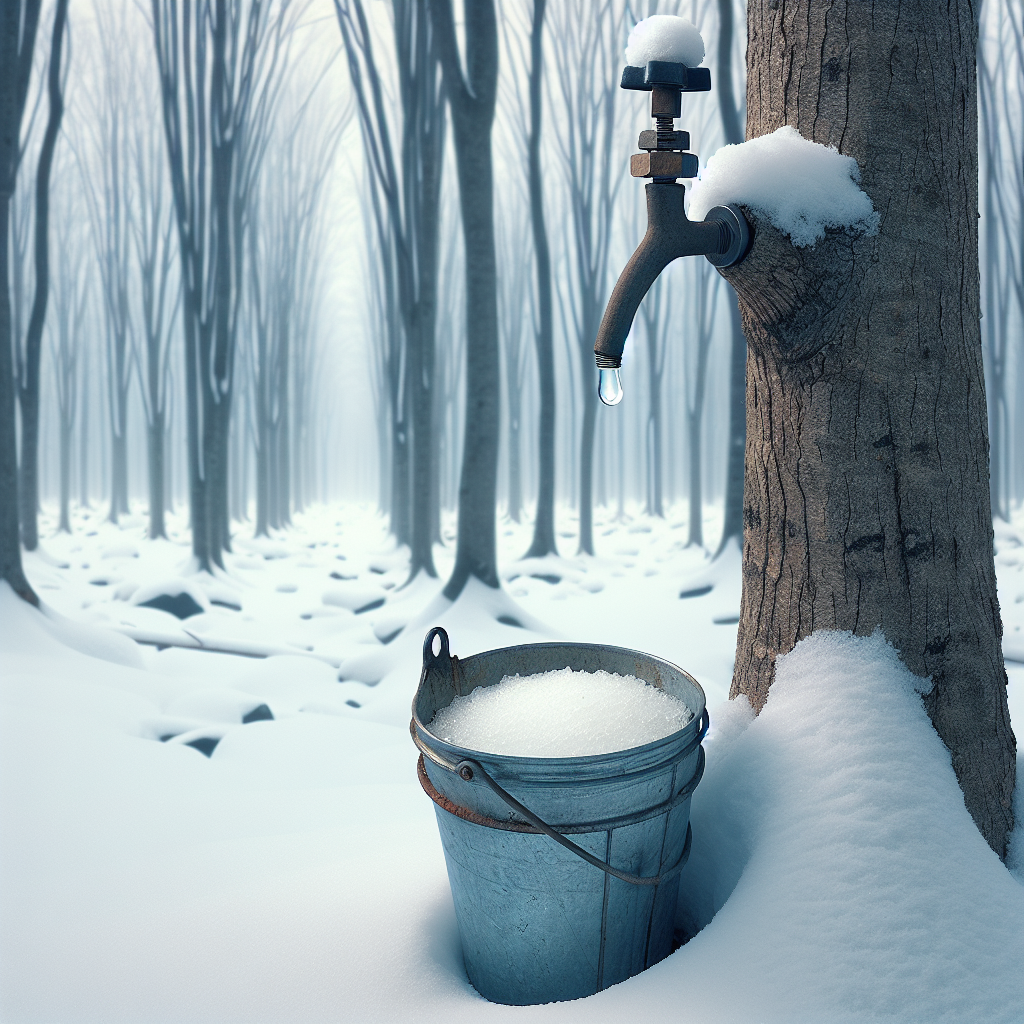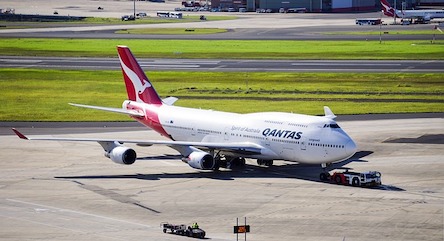Canada’s maple syrup reserve, the only one of its kind in the world, has reached its lowest level in 16 years. This has raised concerns about the future of maple syrup as a beloved sweet staple in the face of climate change. The reserve, located in Quebec, is designed to hold 133 million pounds of maple syrup, but currently only has 6.9 million pounds. Experts attribute the shortage to increased demand and warmer weather, which has disrupted production. However, they assure consumers that the availability and price of maple syrup will not be affected in the near future.
Canada’s maple syrup industry is worth billions of dollars and accounts for 75% of the world’s maple syrup production. The majority of this production, around 90%, comes from the province of Quebec, where the strategic reserve was established 24 years ago. The amount of maple syrup in the reserve has significantly decreased since 2020, now only amounting to 7% of what it was four years ago. Poor harvest seasons in recent years have contributed to this decline.
Maple syrup production relies on a delicate balance of below freezing temperatures at night and warmer temperatures during the day. This allows the maple tree to absorb water from the soil and harvest the sap. However, warmer spring temperatures in 2021 and 2023 led to a 21% reduction in maple syrup production. Despite this, the reserve has been successful in stabilizing supply for buyers, as it was intended to do.
In addition to poor harvest years, there is a growing demand for maple syrup. In 2021, Canada exported 161 million pounds of maple syrup to 71 countries, a 19% increase from the previous year. This demand is due to Quebec’s efforts to promote Canadian maple syrup and its benefits to other countries. With the reserve supply dwindling and demand increasing, the upcoming harvest season will be closely watched.
Despite the challenges, there is reason to be optimistic. The sugaring season has started early this year and production has been plentiful so far. Weather forecasts for the next few weeks are encouraging. Efforts are already underway to replenish the reserve, including the release of 14 million new taps to producers over the past three years. Rebuilding the reserve will be a multi-year process, but it is crucial for stabilizing the maple syrup market.
In conclusion, Canada’s maple syrup reserve is at a 16-year low due to increased demand and warmer weather. However, experts assure consumers that the availability and price of maple syrup will not be affected in the near future. Efforts are underway to replenish the reserve and stabilize the market. The upcoming harvest season will be closely monitored to determine the future of Canada’s iconic export.
Original news source: Canada’s maple syrup reserve hits 16-year low (BBC)
🎧 Listen:
Slow
Normal
Fast
📖 Vocabulary:
| 1 | staple | A basic or essential item used regularly |
| 2 | disrupted | Interrupted or thrown into confusion |
| 3 | strategic | Planned or designed for a specific purpose, often involving military or political objectives |
| 4 | delicate | Sensitive and easily damaged or broken |
| 5 | absorb | To take in or soak up a substance |
| 6 | stabilize | To make or become steady and less likely to change |
| 7 | dwindling | Gradually diminishing in size, amount, or strength |
| 8 | optimistic | Hopeful and confident about the future |
| 9 | replenish | To fill up or restore to a former level or condition |
| 10 | iconic | Widely recognized and well-established |
| 11 | export | A product sent to another country for sale |
| 12 | sap | The fluid that circulates through a plant, carrying water and nutrients |
| 13 | sugaring | The process of making or harvesting sugar, especially from sugar cane or sugar beets, or in this context, maple syrup |
| 14 | taps | Devices or mechanisms that control the flow of liquids |
| 15 | forecasts | Predictions or estimates about future events, especially regarding weather |
Group or Classroom Activities
Warm-up Activities:
– News Summary
Instructions: Divide the class into small groups. Each group will be given a few minutes to read the article. Afterward, they should work together to create a concise summary of the news article, focusing on the main points. Each group will then present their summary to the class, and the class can discuss any differences or similarities between the summaries.
– Opinion Poll
Instructions: Ask the class to form pairs or small groups. Each group will be given a statement related to the article, such as “Do you think climate change will have a long-term impact on maple syrup production?” or “Should the Canadian government take measures to regulate maple syrup production?” Each group will discuss the statement and then take a vote to determine their collective opinion. Afterward, each group will share their opinion and the reasons behind it with the class, promoting a discussion and exchange of ideas.
– Vocabulary Pictionary
Instructions: Write down a list of vocabulary words from the article (e.g., reserve, disrupted, production, balance, demand). Divide the class into small teams. Each team will take turns selecting a word from the list without showing it to the other teams. One member of the team will then have to draw a picture representing the word, while the other team members try to guess the word based on the drawing. The team that guesses correctly earns a point. Repeat the process with different words until all teams have had a chance to draw and guess.
– Headline Creation
Instructions: Divide the class into pairs or small groups. Each group will be given the task of creating a catchy headline for the article. The headline should summarize the main idea of the article while also grabbing the reader’s attention. Each group will present their headline to the class, and the class can discuss the effectiveness of each headline and why it stands out.
– Synonym Challenge
Instructions: Provide the class with a list of key words from the article (e.g., reserve, shortage, production, demand). In pairs or small groups, students will take turns providing synonyms for each word. The group can discuss the different synonyms and their nuances, promoting a deeper understanding of the vocabulary used in the article.
🤔 Comprehension Questions:
1. What is the current level of Canada’s maple syrup reserve?
2. How does warmer weather affect maple syrup production?
3. What percentage of the world’s maple syrup production comes from Canada?
4. How has the amount of maple syrup in the reserve changed since 2020?
5. What factors have contributed to the decline in the reserve’s maple syrup supply?
6. Why has there been an increase in demand for maple syrup?
7. What efforts are being made to replenish the reserve?
8. What will be closely monitored to determine the future of Canada’s maple syrup export?
Go to answers ⇩
🎧✍️ Listen and Fill in the Gaps:
Canada’s maple syrup reserve, the only one of its kind in the (1)______, has reached its lowest level in 16 years. This has raised concerns about the future of maple syrup as a beloved sweet staple in the face of climate change. The reserve, (2)______ in Quebec, is designed to hold 133 million (3)______ of maple syrup, but currently only has 6.9 million pounds. Experts attribute the shortage to increased demand and warmer weather, which has disrupted production. However, they assure consumers that the availability and price of maple syrup will not be affected in the near future.
Canada’s maple syrup industry is (4)______ billions of dollars and accounts for 75% of the world’s maple syrup production. The majority of this production, around 90%, comes from the province of Quebec, where the strategic (5)______ was established 24 (6)______ ago. The amount of maple syrup in the reserve has significantly decreased since 2020, now only amounting to 7% of what it was four years ago. Poor harvest seasons in recent years have (7)______ to this decline.
Maple syrup production relies on a delicate balance of below freezing temperatures at night and warmer temperatures during the day. This allows the maple tree to absorb (8)______ from the soil and harvest the sap. However, warmer spring temperatures in 2021 and 2023 led to a 21% reduction in maple syrup production. Despite this, the reserve has been successful in stabilizing supply for (9)______, as it was intended to do.
In addition to poor harvest years, there is a (10)______ (11)______ for maple syrup. In 2021, Canada exported 161 million pounds of maple syrup to 71 (12)______, a 19% increase from the previous year. This demand is due to Quebec’s efforts to promote Canadian maple syrup and its benefits to other countries. With the reserve supply dwindling and demand increasing, the upcoming harvest season will be closely watched.
Despite the challenges, there is reason to be optimistic. The sugaring season has started early this year and production has been plentiful so far. Weather forecasts for the next few weeks are encouraging. Efforts are already underway to (13)______ the reserve, including the release of 14 million new taps to producers over the past three years. Rebuilding the reserve will be a multi-year process, but it is crucial for (14)______ the maple syrup (15)______.
In conclusion, Canada’s maple syrup reserve is at a 16-year low due to (16)______ demand and warmer weather. However, experts assure consumers that the availability and price of maple syrup will not be affected in the near future. Efforts are underway to replenish the reserve and stabilize the market. The upcoming harvest season will be closely monitored to determine the future of Canada’s iconic export.
Go to answers ⇩
💬 Discussion Questions:
Students can ask a partner these questions, or discuss them as a group.
1. What is your opinion on maple syrup as a beloved sweet staple?
2. How would you feel if the availability and price of maple syrup were affected by the low reserve levels?
3. Do you like maple syrup? Why or why not?
4. Do you think climate change will have a significant impact on the future of maple syrup production? Why or why not?
5. What measures do you think should be taken to address the declining reserve levels of maple syrup?
6. Have you ever tried maple syrup from Canada? If so, how would you describe its taste compared to other types of syrup?
7. What role do you think the maple syrup industry plays in Canada’s economy?
8. How do you think the maple syrup industry can adapt to the challenges posed by climate change?
9. Do you think other countries should try to increase their maple syrup production to meet the growing demand? Why or why not?
10. What are some alternative sweeteners that could be used if maple syrup becomes less available?
11. What impact do you think the low reserve levels of maple syrup will have on the maple syrup market in the long term?
12. How important do you think it is to preserve traditional food products like maple syrup?
13. Have you ever visited a maple syrup farm or participated in the maple syrup production process? If so, what was your experience like?
14. How do you think the decline in maple syrup production will affect the tourism industry in Canada?
15. What steps can individuals take to support the maple syrup industry and ensure its sustainability in the face of climate change?
Individual Activities
📖💭 Vocabulary Meanings:
Match each word to its meaning.
Words:
1. staple
2. disrupted
3. strategic
4. delicate
5. absorb
6. stabilize
7. dwindling
8. optimistic
9. replenish
10. iconic
11. export
12. sap
13. sugaring
14. taps
15. forecasts
Meanings:
(A) Devices or mechanisms that control the flow of liquids
(B) Sensitive and easily damaged or broken
(C) To make or become steady and less likely to change
(D) Gradually diminishing in size, amount, or strength
(E) Planned or designed for a specific purpose, often involving military or political objectives
(F) Widely recognized and well-established
(G) Hopeful and confident about the future
(H) A basic or essential item used regularly
(I) The fluid that circulates through a plant, carrying water and nutrients
(J) Interrupted or thrown into confusion
(K) A product sent to another country for sale
(L) To take in or soak up a substance
(M) Predictions or estimates about future events, especially regarding weather
(N) To fill up or restore to a former level or condition
(O) The process of making or harvesting sugar, especially from sugar cane or sugar beets, or in this context, maple syrup
Go to answers ⇩
🔡 Multiple Choice Questions:
1. Where is Canada’s maple syrup reserve located?
(a) Ontario
(b) British Columbia
(c) Alberta
(d) Quebec
2. How much maple syrup does the reserve currently hold?
(a) 133 million pounds
(b) 90% of the world’s production
(c) 6.9 million pounds
(d) 7% of what it was four years ago
3. What has contributed to the decrease in the reserve’s maple syrup supply?
(a) Decreased demand
(b) Poor harvest seasons
(c) Cold temperatures
(d) Increased production
4. What percentage of the world’s maple syrup production comes from Canada?
(a) 50%
(b) 25%
(c) 75%
(d) 10%
5. What weather conditions are necessary for maple syrup production?
(a) Below freezing temperatures at night and warmer temperatures during the day
(b) Hot temperatures throughout the day
(c) Consistent cold temperatures
(d) Rainy weather
6. What has led to a reduction in maple syrup production?
(a) Colder spring temperatures
(b) Warmer spring temperatures
(c) Increased demand
(d) Poor harvest seasons
7. What has been the trend in maple syrup exports from Canada?
(a) A 19% increase in 2021
(b) A 19% decrease in 2021
(c) No change from the previous year
(d) A 21% increase in 2021
8. What efforts are being made to replenish the maple syrup reserve?
(a) Decreasing production
(b) Importing maple syrup from other countries
(c) Closing the reserve permanently
(d) Releasing 14 million new taps to producers
Go to answers ⇩
🕵️ True or False Questions:
1. Efforts are underway to replenish the reserve and stabilize the maple syrup market.
2. Canada’s maple syrup industry is worth billions of dollars and accounts for 75% of the world’s maple syrup production.
3. Decreased demand and colder weather are the main factors contributing to the surplus of maple syrup.
4. 10% of Canada’s maple syrup production comes from the province of Quebec.
5. Poor harvest seasons in recent years have significantly decreased the amount of maple syrup in the reserve.
6. The reserve is designed to hold 100 million pounds of maple syrup, but currently has 6.9 million pounds.
7. The reserve is located in Quebec and is the only one of its kind in the world.
8. Canada’s maple syrup reserve is at its highest level in 16 years.
Go to answers ⇩
📝 Write a Summary:
Write a summary of this news article in two sentences.
Writing Questions:
Answer the following questions. Write as much as you can for each answer.
1. What is the current level of Canada’s maple syrup reserve?
2. What factors have contributed to the decline in the reserve’s supply?
3. How does maple syrup production rely on specific temperature conditions?
4. Why has there been a growing demand for maple syrup in recent years?
5. What efforts are being made to replenish the reserve and stabilize the maple syrup market?
✅ Answers
🤔✅ Comprehension Question Answers:
1. What is the current level of Canada’s maple syrup reserve?
The current level of Canada’s maple syrup reserve is 6.9 million pounds.
2. How does warmer weather affect maple syrup production?
Warmer weather disrupts maple syrup production by preventing the maple tree from absorbing water from the soil and harvesting sap.
3. What percentage of the world’s maple syrup production comes from Canada?
Canada accounts for 75% of the world’s maple syrup production.
4. How has the amount of maple syrup in the reserve changed since 2020?
The amount of maple syrup in the reserve has significantly decreased since 2020, now only amounting to 7% of what it was four years ago.
5. What factors have contributed to the decline in the reserve’s maple syrup supply?
Poor harvest seasons in recent years and increased demand for maple syrup have contributed to the decline in the reserve’s maple syrup supply.
6. Why has there been an increase in demand for maple syrup?
There has been an increase in demand for maple syrup due to Quebec’s efforts to promote Canadian maple syrup and its benefits to other countries.
7. What efforts are being made to replenish the reserve?
Efforts to replenish the reserve include the release of 14 million new taps to producers over the past three years.
8. What will be closely monitored to determine the future of Canada’s maple syrup export?
The upcoming harvest season will be closely monitored to determine the future of Canada’s maple syrup export.
Go back to questions ⇧
🎧✍️✅ Listen and Fill in the Gaps Answers:
(1) world
(2) located
(3) pounds
(4) worth
(5) reserve
(6) years
(7) contributed
(8) water
(9) buyers
(10) growing
(11) demand
(12) countries
(13) replenish
(14) stabilizing
(15) market
(16) increased
Go back to questions ⇧
📖💭✅ Vocabulary Meanings Answers:
1. staple
Answer: (H) A basic or essential item used regularly
2. disrupted
Answer: (J) Interrupted or thrown into confusion
3. strategic
Answer: (E) Planned or designed for a specific purpose, often involving military or political objectives
4. delicate
Answer: (B) Sensitive and easily damaged or broken
5. absorb
Answer: (L) To take in or soak up a substance
6. stabilize
Answer: (C) To make or become steady and less likely to change
7. dwindling
Answer: (D) Gradually diminishing in size, amount, or strength
8. optimistic
Answer: (G) Hopeful and confident about the future
9. replenish
Answer: (N) To fill up or restore to a former level or condition
10. iconic
Answer: (F) Widely recognized and well-established
11. export
Answer: (K) A product sent to another country for sale
12. sap
Answer: (I) The fluid that circulates through a plant, carrying water and nutrients
13. sugaring
Answer: (O) The process of making or harvesting sugar, especially from sugar cane or sugar beets, or in this context, maple syrup
14. taps
Answer: (A) Devices or mechanisms that control the flow of liquids
15. forecasts
Answer: (M) Predictions or estimates about future events, especially regarding weather
Go back to questions ⇧
🔡✅ Multiple Choice Answers:
1. Where is Canada’s maple syrup reserve located?
Answer: (d) Quebec
2. How much maple syrup does the reserve currently hold?
Answer: (c) 6.9 million pounds
3. What has contributed to the decrease in the reserve’s maple syrup supply?
Answer: (b) Poor harvest seasons
4. What percentage of the world’s maple syrup production comes from Canada?
Answer: (c) 75%
5. What weather conditions are necessary for maple syrup production?
Answer: (a) Below freezing temperatures at night and warmer temperatures during the day
6. What has led to a reduction in maple syrup production?
Answer: (b) Warmer spring temperatures
7. What has been the trend in maple syrup exports from Canada?
Answer: (a) A 19% increase in 2021
8. What efforts are being made to replenish the maple syrup reserve?
Answer: (d) Releasing 14 million new taps to producers
Go back to questions ⇧
🕵️✅ True or False Answers:
1. Efforts are underway to replenish the reserve and stabilize the maple syrup market. (Answer: True)
2. Canada’s maple syrup industry is worth billions of dollars and accounts for 75% of the world’s maple syrup production. (Answer: True)
3. Decreased demand and colder weather are the main factors contributing to the surplus of maple syrup. (Answer: False)
4. 10% of Canada’s maple syrup production comes from the province of Quebec. (Answer: False)
5. Poor harvest seasons in recent years have significantly decreased the amount of maple syrup in the reserve. (Answer: True)
6. The reserve is designed to hold 100 million pounds of maple syrup, but currently has 6.9 million pounds. (Answer: False)
7. The reserve is located in Quebec and is the only one of its kind in the world. (Answer: True)
8. Canada’s maple syrup reserve is at its highest level in 16 years. (Answer: False)
Go back to questions ⇧












